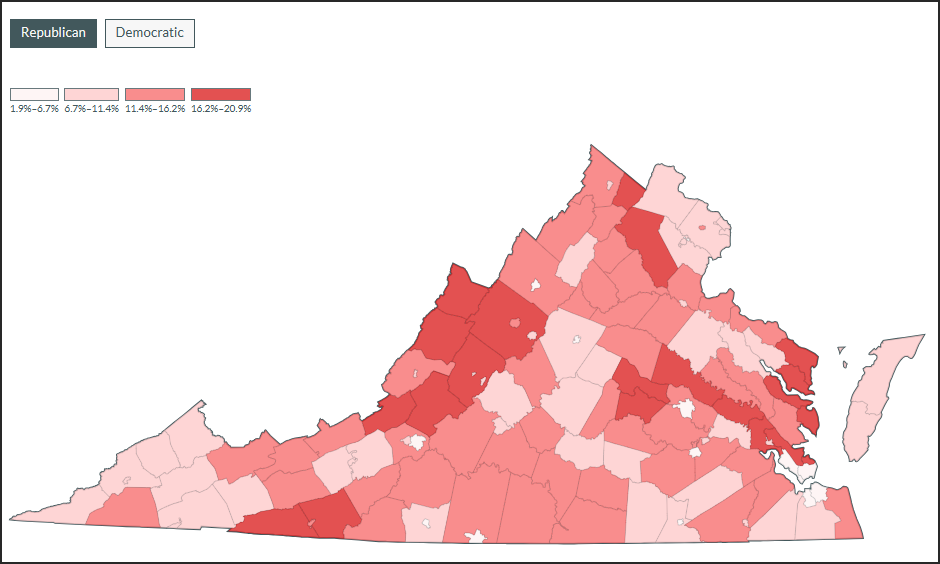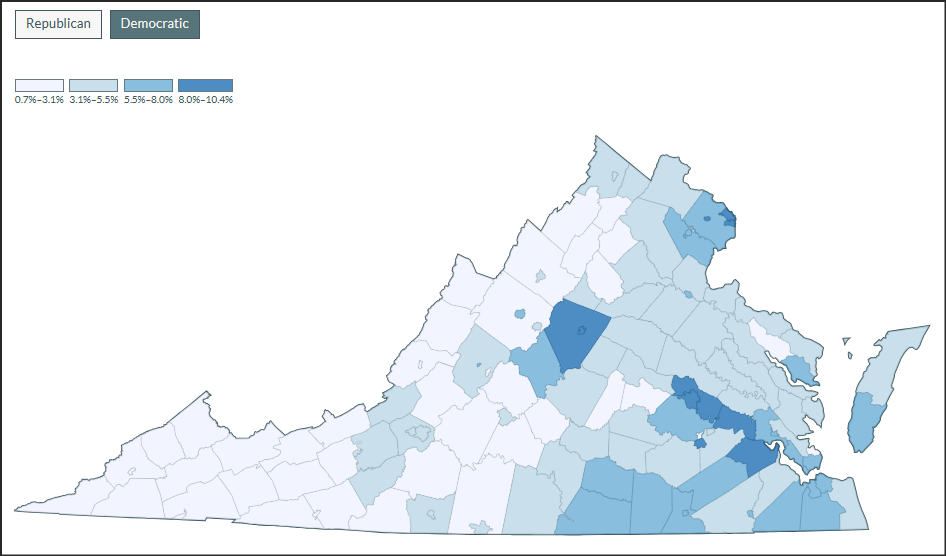 by James A. Bacon
by James A. Bacon
I’m no reader of the political tea leaves, and I will willingly defer to those better informed than I am, but it appears that the presidential primary vote in Virginia showed a greater level of enthusiasm for Republicans than for Democrats. That may simply reflect the fact that in the Republican primary Donald Trump had a credible (or semi-credible) challenger, while the Democratic primary offered no serious alternative to President Joe Biden. But I think there’s more to the story than that.
Top-line numbers: 690,000 votes were cast for Republican presidential candidates compared to only 346,000 for Democrat candidates.
Digging into the details, I replicate here two maps published by the Virginia Public Access Project. (Click here to view the interactive maps with a breakdown of turnout by locality.) The first thing to note is the scale used to measure the turnout in each locality — 1.9% to 20.9% for Republicans and 0.7% to 10.4% for Democrats. That alone tells you that Republican turnout was higher as a percentage of registered voters across the board.

Remarkably, Republican voting (10.6% of registered voters) in Virginia’s most populous jurisdiction, Fairfax County, exceeded that of Democrats (7.5%). The picture was the same in other Northern Virginia Democratic strongholds such as Loudoun County (10.7% to 5.3%) and Prince William (9.6% to 5.8%).
Blue turnout exceeded red only in a handful of localities, such as the peoples’ republics of Arlington and Charlottesville and overwhelmingly Democratic cities with large African-American populations like Richmond, Petersburg and Portsmouth. Even there, blue votes exceeded red by narrow margins.
By contrast, the elephant stomped the donkey in traditionally red jurisdictions — 20.9% GOP in Clarke County compared to 5.3%, 20.8% in Hanover County compared to 4.1%, and 16.6% in Augusta County compared to 2.2%.
Participation in the Republican primary was undoubtedly boosted by Democrats crossing over to cast votes for Nikki Haley. That effect is hard to measure. But if it were a factor, one would expect to see the biggest divergences from past voting patterns in heavily Democratic localities. My hunch is that the crossover effect was modest, but I would be happy to see anyone’s analysis that suggests otherwise.
At the end of the day, Virginia still leans blue in presidential races. I don’t expect 2024 to be an exception. Democratic turnout will surge in the general election when the stakes are much higher. Furthermore, a number of Haley voters are likely to vote Democrat or Independent rather than mark the ballot for Trump in November, while desertions by Williamson and Philips voters from the Democratic ticket would be inconsequential. But the turnout in Tuesday’s primary suggests that GOP voters are more fired up than Dem voters, and the Trump-Biden race could be closer than anyone expects.

Leave a Reply
You must be logged in to post a comment.